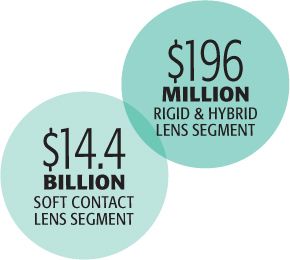Contact lens market expected to grow to $20.1 billion by 2018
A recent report from BCC Research, a publisher of technology market research reports, projects the contact lens market to grow from $18.9 billion in 2013 to $20.1 billion by 2018, a compound annual growth rate of 1.2 percent over the five-year period.

Wellesley, MA-A recent report from BCC Research, a publisher of technology market research reports, projects the contact lens market to grow from $18.9 billion in 2013 to $20.1 billion by 2018, a compound annual growth rate of 1.2 percent over the five-year period.
Soft contact lenses are expected to continue to dominate the marketplace, and BCC Research expects this segment to grow to approximately $14.4 billion by 2018. Rigid and hybrid lenses have seen technological improvements, but this segment is projected to grow by a compound annual growth rate of only one percent to $196 million over the next five years.
The report, which was conducted by a team of professionals in the biotechnology industry and lead by project manager Shalini S. Dewan, suggested several reasons for the growth, including new technologies and sales increase in both developed and developing nations. The report suggest the emerging market for contact lenses includes:
• India
• China
• Japan
• Korea
• Taiwan
• Africa
• Australia
• Canada
• New Zealand
"While broad research in the field of contact lenses has revealed that the market is rising with time in developed countries, markets in developing countries are also showing progressive growth," says Dewan. "An aging population, affordability, and increasing access to healthcare in this region are the major forces driving market."
According to BCC Research, the market is expected to grow as various age groups explore the advantages of wearing contact lenses. Several factors-including innovation, target, and price-have altered the market’s approach and have led to the steady market for contact lenses.
“R&D spending, along with increasing competition, patent expiries, and new technologies, will take it to a new direction. The advancements, new product launches, and the changing lifestyle have influenced the market to grow in the near future,” says the BCC Research report.
The researchers gathered data from various industry sources, including contact lens manufacturers, journals, industry officials, and company and product literature.ODT